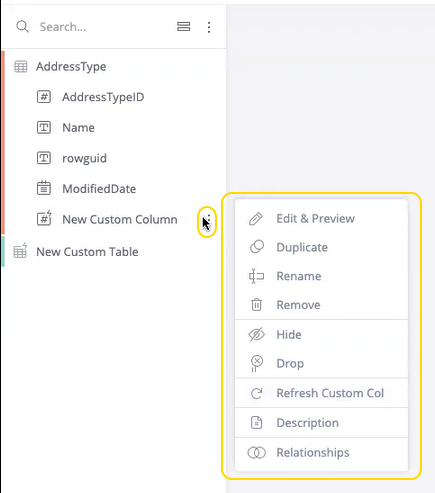Using the Model Editor
In the Model Editor, you can work with tables you have connected to from an ElastiCube source on two levels - the table level and the column level.
Table Level
You can manage tables through the Navigation Pane or through the table itself in the schema.

Below are the menu options available from the Navigation Pane.
.png)
| Navigation Pane | Description |
|---|---|
| Preview | Displays a preview of your table's data. |
| Duplicate | Duplicates the table. |
| Rename | Enable you to rename the table. |
| Delete | Deletes the table. |
| Add Custom Code | Enables you to add custom code to the table. |
| Create as View (/ Create as Table) | Enables creating a table as view-only for B2D, so users can read from tables without
making entirely new copies of them in the CDW. After creating a table as view, the "Create as View"
option changes to "Create as Table" to enable changing the table to a writable copy of the table.
|
| Hide All Columns | Hides all columns. |
| Drop All Columns | Drops all columns. |
| Refresh Schema
|
Updates the table's columns if there was a change on the data source, without having
to add the table again.
|
| Connection Settings | Enables you to change the connection settings. See Changing Connection Settings for Data Sources. |
| Tags & Description | Enables you to tag a table with metadata that you can use to organize your data and
search for it later. See Creating Data Dictionaries.
|
| Add Custom Column | Adds a custom column. |
| Build Behavior | When performing a build, enables you to define if the new data will replace the existing data, or be appended to it, or if it will only include the changes. |
| Relationships | Enables you to select two tables and a column to create a relationship. See Creating and Removing a Relationship Between Tables. |
To view your table's metadata, including its name, path, provider, location, and the number of columns it contains, hover over the table in the schema or in the Navigation Pane.
Column Level
Columns that are part of a table are displayed below the table in the Navigation Pane.

To the left of the column name is an icon that indicates the column's data type.
If the column is connected to another table through a relationship, a connection icon appears to the right of the column name. You can hover over the connection icon to view more details or disconnect the relationship.

Click the three-dot menu icon next to any column's name to display a menu with options for managing the column:

| Menu Option | Description |
|---|---|
| Edit & Preview | Displays a preview of your column's data and enables you to edit it.
|
| Duplicate | Duplicates the column. |
| Rename | Enable you to rename the column.
|
| Remove | Removes the column. |
| Hide | Hides the column. |
| Drop | Drops the column, |
| Refresh Custom Col | Updates the column if there was a change on the data source, without having to add the table / column again.
|
| Description
|
Enables you to tag a column with metadata that you can use to organize your data and search for it later. See Creating Data Dictionaries.
|
| Relationships |
Displays related columns side by side. See Creating and Removing a Relationship Between Tables. |
| Edit Relationship |
Enables you to edit a column's relationship. This option is only available when the column is connected to another table. |